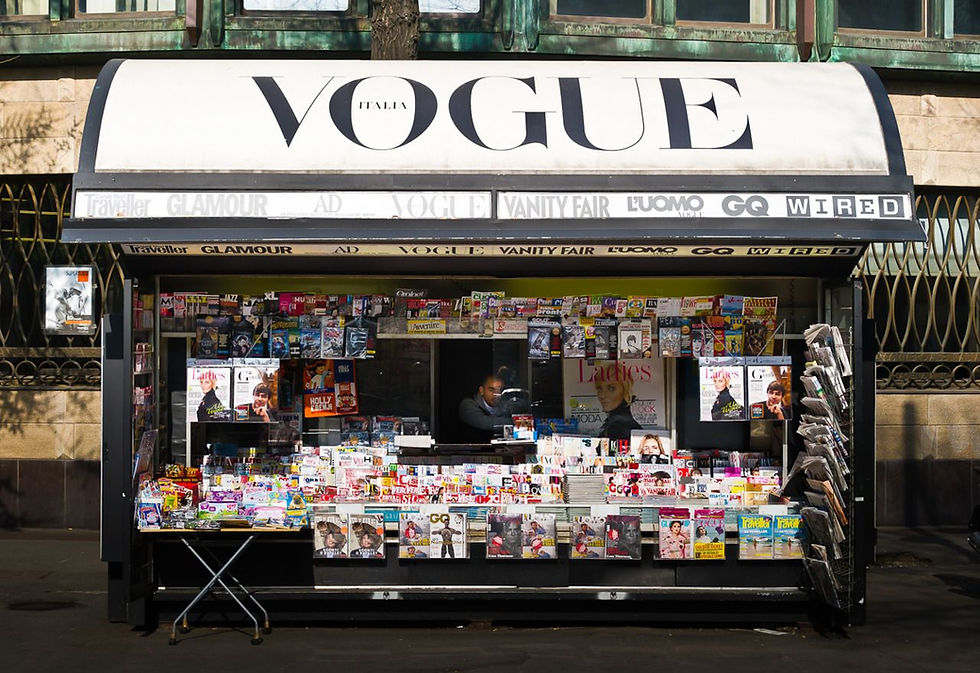Consumption of the printed Vogue magazine
- Maya Bragh

- 17. nov. 2020
- 3 min læsning
The consumption of the fashion media has been expanding in the last decade, because of the technological changes in the society. This means that there are more people who are able to read about fashion, trends and other related topics than ever before. But the new technology is causing problems for the traditional printed magazine, who seems to be losing their costumers to the more reachable online magazines, blogs and social media (Kay, 2017).
So what is that reputable magazines, such as Vogue, are currently doing to keep their customers, and what is that makes the costumers want to consume/buy the magazine?
The Historical framework for Vogue Magazine
The idea of a fashion magazine began as a catalog, where women could leaf through and order the design that they liked. This meant that the main purpose of fashion magazine was to sell products (Miller & Mcneil, 2018). When the catalog later on develop into a magazine, it also became a communication tool for the fashion industry, which meant that the magazine now was filled with advertising, trends and the latest news concerning fashion, it was the 19050’s form of internet This development meant that the magazine now had to forms of consumers, the advertisers and the regular consumer (Hoskins, 2014).

Consumers before and today
When Vogue launched their first magazine in 1892, it was primarily meant for the wealthy minority because they would attract more advertisers (Hoskins, 2014). It could be a difficult situation, because the wealthiest part of the public is old, but Vogue wanted to attract younger women (Twigg, 2013). When a woman bought an issue of the Vogue magazine, they bought it because It gave them the newest form of insight to the former fashion trends, it was the only source of direct fashion information, that existed at that time. There were of course also other magazines at the time, but Vogue was one of the most dominant ones (Hoskins, 2014).
Since the internet was discovered, more and more of the traditional media, has been replaced by the online media platforms. This evolution made all the information about the fashion industry available for free online, and since the younger generation have a larger understanding of the internet, they are also the primarily user that Vogue seems to be losing. Therefore, Vogue ended up having to accept the fact, that their biggest consumer now are older women (Twigg, 2013).
When a woman buys an issue of Vogue today, she buys it because it is something tangible, she can browse through. It can be prepared to the reason why we read books, it is the feeling of getting transported to a fantasy world, in this case the world of high fashion (Kay, 2017).

Critical issues
Vogue are using advertisers in their magazines to gain profit, but the one of problems that they have met in recent times are the increasing number of influencers online. Influencers are a cheaper communications tool for the advertisers, which means that many advertisers tend to abandon the printed magazine (Bella Vidorra, 2020). This problematic issue is something that is seemingly becoming one of the largest issues for Vogue, because the advisers are the most important consumer that Vogue has.
Vogue has always been very strict about the front page of their magazine; this means that the model/models who are chosen to be on cover of it often has to inspire in some way. Beforehand they used to choose the simple white girl, because she represented the perfect ideal for the women who used to read the magazine. But that has changed a lot, now they are trying to use women of all kind. It is still something that they need to work a lot more on, but they are moving in the right direction, if they want a broader spectrum of consumers (Nnadi, 2020)
There a lot of different problems that the vogue magazine has to face today, but is they start focusing on areas that beforehand has been neglected, they might have a chance of growth again. A solution might be to look at the possibility of making the magazine become a form of coffee table book, something that is both informative, decorative and a cultural symbol. There are many ideas towards what the solution might be, but it is up to Vogue to make it happen.
References:
1. Bella Vidorra. (4. Februar 2020). Will Fashion Print Media Ever Die? Hentet fra Bella vidorra: https://bellavidorra.com/home/2019/5/4/will-fashion-print-media-ever-die
2. Hoskins, T. E. (2014). Stiched up - The anti-capitalist book of fashion. London: Pluto Press.
3. Kay, K. (9. Juli 2017). Does the fashion industry still need Vogue in the age of social media. Hentet fra The Guardian: https://www.theguardian.com/fashion/2017/jul/08/does-fashion-industry-need-vogue-in-instagram-age
4. Miller, S., & Mcneil, P. (2018). Fashion Journalism - History, Theory and practice. London: Bloomsbury.
5. Nnadi, C. (12. Marts 2020). Models from around the world celebrate today's global runway - in a gorgeous mosaic of denim. Hentet fra Vogue: https://www.vogue.com/article/global-models-cover-april-2020
6. Twigg, J. (2013). Fashion and age. New York: Bloomsbury.


Kommentarer